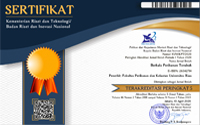Characteristics Quality Sensory and Chemical of Cincalok Rebon Shrimp (Acetes eryhraeus) Made Using the Method Backslopping
Abstract
This study aims to determine the duration of the fermentation process, and aims to determine the effect of the addition of the substrate from the previous fermentation on the sensory quality and chemical properties of the chopped rebon shrimp made by the Backslopping method. The study method used was experimental with a fully randomized design (CRD). With 4 treatment levels, namely the addition of substrate 0%, 10%, 15% and 20%, the percentage is calculated based on the weight of the shrimp reconstruction. The results showed that the addition of substrate to the cincalok fermentation product had a significant effect on the organoleptic values (appearance, aroma, taste and texture), pH, NPN and amino acids. The best treatment is 20% with the characteristics of attractive appearance, bright light pink color and not pale; it does not smell fishy and has a characteristic sour aroma of cincalok fermentation; it has a slightly salty taste and a sour taste, the texture is firm and slightly runny. The 20% treatment has a pH value of 3.5 during the 5 day fermentation period, the NPN value is 10.05%, the water content is 68.50%, the ash content is 9.67%, the fat content is 1. 46%, the protein content is 35.27, the carbohydrate content is 7.53% and the higher the substrate is added, the feed is more high sugar content 11.10%, arginine 5.93%, leucine 7.88 and low glycine content 2.93%.
Keywords
Full Text:
PDFReferences
Akanbi. 2009. Functional And Pasting Properties Of A Eropical, Osun State, Nigeria. International Food Research Journal, 16: 151-157.
Alvarando S, Garcia Almandarez BE, Martin SE, Regalado C. 2006. Food-Associated lactic acid bacteria waith antimicrobial potential from tradisional Mexican foods. Microbiologia. 48: 206-268.
Aryanta, R. W. Fllet, G. H., dan Buckle, K.A. 2003. The Occurrence And Growth Of Microorganisms During The Fermentation Of Fish Sausage. Journal Of Departemen Of Food Sciene Of Technology. 2: 143-55.
Aulia, Hana, Anggoro, Bambang Sri, Maretta, Gres dan Kesuma, Andri Taya. 2018. Pengaruh Penambahan Berbagai Kosentrasi Kunyit (Curcuma longa L.) Terhadap Mutu Bekasam Ikan Lele Sangkuriang (Clarias gariepinus). BIOSFER Jurnal Tadris Pendidikan Biologi Vol. 9 no.1 (2018) 84-99
Badan Pusat Statistik Riau. 2017. Data Produksi dan Nilai Perikanan Laut Menurut Jenis. 2014-2015.
Batubara, Pebry Aisyah putri, Desniar, setyaningsih, iriani. 2019. Pengaruh stater bakteri asam laktat probiotik terhadap perubahan kimiawi dan mikrobiologi rusip. Jurnal teknologi dan industri pangan. Vol 30(1): 28-35 Th. 2019 ISSN 1979-7788.
Bertoldi FC, Sant’anna ES, Beirao LH. 2002. Reducing the bitterness of tuna (Euthynnus pelamis) dark meat with Lactobacillus casei subsp. Casei ATCC 392. Journal Food Technology and Biotechnology 42 (1): 41-45.
Chaijan, M dan Panpipat, W. 2012. Darking Prevention of femented shrimp paste by pre-soaking whole shrimp with pyrophshopate. Asian joural food and argo-industry 5 (2): 163-171
Cullison, A. E. and R. S. Lowrey. 1987. Feeds and feeding. 2nd Ed. Prentice- hall of India Put. Ltd. New Delhi.
Desniar, Setyaningsih, Iriani, dan Sumardi, Retno Santi. 2012. Perubahan Parameter Dan Mikrobiologi, Serta Isolasi Bakteri Penghasil Asam Selama Fermentasi Bekasam Ikan Mas (Cyprinus Carpio). Jurnal Masyarakat Pengolahan Hasil Perikanan Indonesia. Vol. 15. No. 3. Diakses pada tanggal 23 Juli 2020
Herawati DA, Wibawa AA. 2011. Pengaruh kosentasi susu Skim dan Waktu Fermentasi Tehadap Hasil Pembuatan yoghurt. Jurnal ilmiah teknik lingkungan. 1 (2): 452-329.
Hidayat, N, Padaga, M. C, Suhartini, S. 2006. Mikrobiologi industri, Edisi kedua. Yogyakarta: Andi Offsed. Halaman 155-158.
Holzapfel,W.H., R. Geisen, and U. Schillinger. 1995. Biological preservation offoods with reference to protective cultures, bacteriocins and food-gradeenzymes. International Journal of Food Microbiology (24): 343-362
Hutkins, R. W. 2006. Microbiology and technology of fermented food. Blackwell Publishing, lowa: xi+473 hlm.
Irianto, H.E. 2012. Produk Ikan Fermentasi Tradisional Indonesia. Jakarta: Balai Besar Riset Pengolahan Produk dan Bioteknologi Kelautan dan Perikanan. Badan Riset Kelautan dan Perikanan.
Koesoemawardhani D, Rizal S dan Tauhid M. 2013. Perubahan sifat mikrobiologi dan kimiawi rusip selama fermentasi. Agritech 33(3):348-355.
Katoch, R. (2011). Analytical Techniques in Biochemistry and Molecular Biology.New York: Springer. Halaman 332-333.
Lesmayati, S dan E.S. Rohaeni. 2014. Pengaruh lama pemeraman telur asin terhadap tingkat kesukaan konsumen. Prosiding Seminar Nasional. Inovasi Teknologi Pertanian Spesifik Lokasi. 601-695
Nofiani, R dan Puji A. 2018. Physicochemical And Microbiological Profiles Of Commercial Cincalok From West Kalimantan. Department of Chemistry, Faculty of Mathematics and Natural Sciences, Universitas Tanjung pura.
Nuraida L, Owens JD, Bakar JA. 2014. Lactic Vegetable and Fruit Fermentations. In: J.D. Owens (Ed.), Indigenous Fermented Foods of Southeast Asia. CRC Press. hlm 185–209.
Putri, Dewi Citra Laksmi Agung, Putra, 1 Nengah Kencana dan Suparthana, 1 putu. 2019. Pengaruh Penambahan Sari Buah Naga Merah (Hylocereus polyrhizus) Terhadap Karakteristik Yoghurt Campuran Susu Sapi Dan Kacang Merah (Phaseolus valgaris). Jurnal Ilmu Dan Teknologi Pangan. Vol. 8, no. 1, 18-17. Diakses pada tanggal 23 Juli 2020.
Rahmadi, D. 2003. Pengaruh Lama Fermentasi Dengan Kultur Mikroorganisme Campuran Terhadap Komposisi Kimiawi Limbah Kubis. Journal Of The Indonesian Tropical Animal Agriculture. 28(2). Diakses pada tanggal 23 Juli 2020.
Rosmaniar. 2018. Pengaruh penambahan jumlah garam yang berbeda pada cincalok udang rebon (acetes eryhraeus) terhadap penerimaan konsumen. Jurnal Online Mahasiswa. Fakultas Perikanan dan Kelautan Universitas Riau. Pekanbaru.
Soetrisno USS dan Apriyantono RRS. 2005. Mutu Gizi Dan Keamanan Bekasam Produk Fermentasi Ikan Teri Secara Spontan Dan Penambahan Kultur Murni. Jurnal Penelitian Gizi dan Makanan. 28 (1): 38-42
Suparmo. 1989. Aspek Nutrisi Proses Fermentasi.Pusat Antar Universitas Pangan dan Gizi Universitas Gadjah Mada, Yogyakarta.
Suwandi, Rohannah A dan Rindang, A. 2017. Uji Komposisi Bahan Baku Teri Dengan Menggunakan Alat Pencetak Terasi. Jurnal Rekayasa Pangan Dan Pertanian. 5:196-201.
Winarno F.G. 2008. Kimia pangan dan Gizi. PT Gramedia Pustaka Utama. Jakarta
Yuktika S. Ekris S. Endha S D. Shinta D M. Rizqa D S. 2017. Pengaruh Variasi Konsentrasi Garam Terhadap Kualitas Fermentasi Udang The Influence Of Salt Concentration On The Fermentation Of Shrimp. Universitas Negeri Surabaya. Jawa Timur.
Zhang, M, Ebrahimpour A, Abu Bakar F, Mohamed AKS, Forghani B, Ab–Kadir MS. 2012. A glutamic acid – producing lactic acid bacteria isolated from Malaysian fermented foods. Int J mol Sei B. 5497. 5497. Dol: 10. 339 olijms13055482.
DOI: http://dx.doi.org/10.31258/terubuk.48.3.621-633
Refbacks
- There are currently no refbacks.
Copyright (c) 2021 Stefani Rani Audina, Bustari Hasan, Tjipto Leksono

This work is licensed under a Creative Commons Attribution 4.0 International License.












